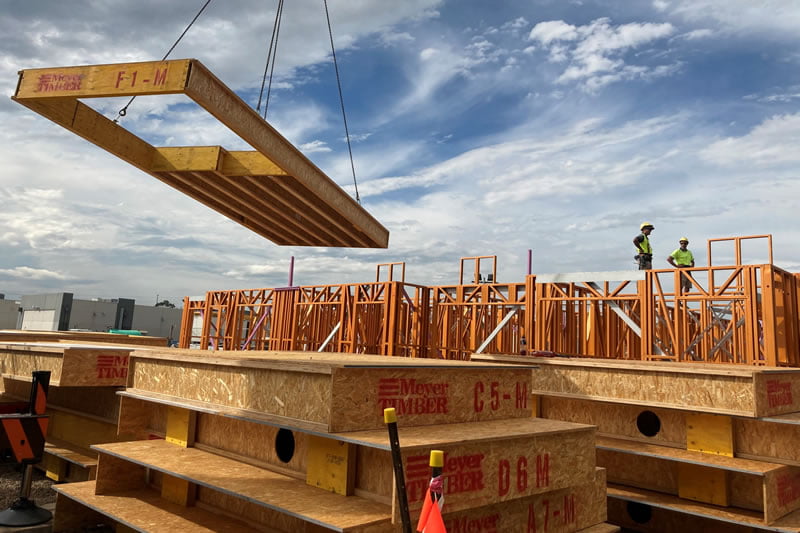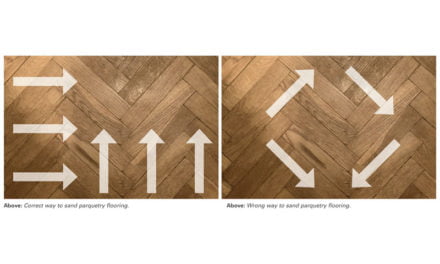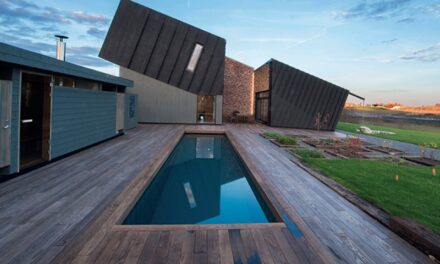With timber and labour supply constrained, cassettes offer achievable, affordable solutions to major construction problems.
Here’s the short version of this article if you don’t have time for the whole thing. “We’re just in the final stages of a big project out at Mount Annan for 140 townhouses built by Sunland Group,” says Thomas Horsfall, project engineer at Meyer Timber.
“On our best day, we installed cassette floors for nine units. They’re stoked! The stick floors we typically supply to them might take a day per floor to install, so every time a cassette floor goes in, we save them about a day on their construction program. Multiply 140 units by a day a floor and they think they’re at least six months ahead of schedule, purely thanks to floor cassettes.”
If you only have time for the soundbite, that’s it: cassette construction can take a huge amount of time out of a build schedule. At the same time, it gets optimal use out of resources that are currently scarce, provides a good new earnings line for fabricators, is almost always as cost effective or better than a stick floor and can both deal with tricky sites and potentially open up new markets… We’re getting beyond the soundbite here, best read on.
Speed and ease
Technically, a cassette is a set of joists/trusses covered with a sheet of flooring. It’s something most fabricators can do, and many already are. There’s no need for anything more advanced than most fabricators already have: a CNC or dropsaw for cutting joists, floor sheets can be cut either with a panel saw or track saw and then add a jig for the panels, and then construction uses standard nail guns in a basic table or squaring fence. The only specialist requirement is enough room in your plant for staging the finished units.
Dimensions of floor cassettes are governed by the width of the truck they’ll be transported on (usually a maximum around 3m) and the size of the room they’re for.
Several major timber suppliers already supply cassettes as a product line. Tilling was one of the first, with its SmartStruct division designing, engineering and producing SmartFloor cassettes around its TecBeam floor joists.
Meyer Timber has both been training fabricators in cassette production and producing its own, with recent jobs including several ground-floor cassette projects (cf an installation on a sloping site in Victoria in May 2021 TTN) as well as Mount Annan.
“The townhouses at Mount Annan came in four designs and used three different types of floor cassette systems,” says Horsfall.
“The biggest cassettes were around 2.7x10m and they were all produced at our factory in Penrith. The pieces were cut on our Hundegger Turbodrive and then we had a jig set up for assembling the panels and a table saw for cutting the floor sheets.
“The footprint is something you need to think about with cassettes. We stage them up; we might have anywhere up to about 12 units-worth ready to go before they’re delivered out to site and you’ll get up to two units per truck.”
Prefabricating offsite shifts both costs and time in the build, but it’s not a case of shuffling a block of time out of the build and into the preparation. “We can be making the cassettes at the same time they’re starting works and it’s easy for us to keep pace with the build,” Horsfall says. “It’s a challenge with supply at the moment, but we’re well placed in that supply chain as a wholesaler. The other advantage is that we get orders months out for these large projects, so that helps with planning and supply.
“Material costs are similar, but there are additional costs, including design and transport for the finished cassettes. But they can be offset by the lower installation costs. There’s also much less wastage; because the factory is a controlled environment, we can re-use a lot of our offcuts for other products.”
One difference in the floor construction is adhesives: cassettes have better quality control when it comes to glueing floor sheets than is possible to manage on site, and in many cases use a superior glue. “We’re actually using the same adhesive they use to hold glulam beams together,” says Horsfall, “so the floor sheets are chemically bonded to the top of the joist. Just that glue bond can give you up to a 30% stiffness boost across the floor. It gives a lot of confidence knowing the controlled conditions it’s been applied in, versus something that’s applied out in the weather.”
While cassettes have been available in Australia for some time, they’re new enough that the installation costs haven’t yet come down as far as they will, but the time saving alone is justifying the method. Both factors will improve as builders gain experience. “They’re able to produce more houses every month, which is an advantage when it comes to labour shortages,” says Horsfall.
“One thing they found on this project is that because the floors were going in so quickly, there was a lag with the other trades, then suddenly there was pressure on the cladders and they went from needing one cladding crew to four cladding crews, just to keep up with the framing. Builders need to be prepared to organise maximise trades to maximise the benefits, but carpenters are freed up faster to work elsewhere on the project.”
More than townhouses
Multi-residential projects like Mount Annan represent the current biggest market for cassette building, but there’s scope for much more. Cassettes are ideal for difficult sites, where, even for a single residential build, the costs of prefab, transport and crane hire can be much lower than those of traditional builds – and with fewer safety risks. They also represent a considerable advantage for mid-sized commercial and public builds
“We’re working on a prototype school at the moment with Schools Infrastructure NSW,” says Tim Strong, general manager Viridi Group. “It’s a school at Fern Bay, up near Newcastle. Lipman is the builder and we’re providing a solution around floor cassettes, wall panels and roof modules. We think this could be quite a big area, moving forward, especially if they take the model that we’re working with them on into the replacement of demountables scheme. There are thousands of demountable buildings the NSW government has been promising to replace for years.”
Strong was previously a director at Strongbuild, which was a pioneer in full delivery prefabrication solutions. In contrast, Viridi Group is focused on design, education and manufacturing, relying on builder partners for the installation.
“For projects like this, we use our standard wall line and our floor line – Randek machinery that we got through Bliss & Reels,” Strong says.
“We worked with Lipman back in my Strongbuild days on a solution for the Macquarie University Incubator Hub. They definitely are innovative in wanting to use the new modalities, but I think the fact that we are purely a manufacturer has made it easier when it comes to opening up builders’ eyes to looking at prefabricated products. We’ve had a long list of other builders talking with us about delivering into this space because they can see that we’re minimising works on site. To the builder, that lowers the risks around safety issues, because you have fewer people on site.”
For projects like the schools build, the safety difference from prefabricated elements such as cassettes is notable, but when it comes to the bigger projects Strong has worked on in the past, it’s entirely game changing. “We did a job for Aveo at Norwest, which is a 10-storey structure out of mass timber,” he says. “We had six to eight carpenters building that structure from start to finish when it came to the timber component. If that was concrete, we’d typically have 85-130 tradies on site every day trying to get that structure done. It drastically reduces the working at height risk. So around safety concerns, people are really starting to understand this system’s benefits, which will help grow these systems at the top end.”
Material benefits
One of the big benefits of cassettes is that there is no prescribed recipe for them. A range of timbers, webbings and floor sheetings are ideal as components and allow for specialist designs, such as wet areas or lighter weights. And now some manufacturers are creating product specified particularly for cassette construction.
Stuart Toakley, sales and marketing manager at Australian Panel Products has been selling particleboard flooring for three years. “Many people have said to us that they’re making or about to start making cassettes and the thing they want is particleboard in 2.7m lengths,” he says.
“That’s because they can make a cassette that is 2.7m wide and then easily fit that on the truck for delivery to site with a standard truck width of 2.4m.”
In response, Australian Panel Products has had its Mount Gambier particleboard factory certified to make 19mm general purpose flooring. “And the press we’re making that product on is 5.4m long, which means we can cut that in half to two 2.7m lengths,” says Toakley. “So we can make as many 2.7m lengths of flooring as the cassette market could ever require. It’s providing a part of the jigsaw these guys need if they want to grow this market.”
The company’s other factory in Oberon NSW still provides 3.6m lengths and both sites can meet the current elevated demand. Toakley says, “Having the two particleboard factories and the second one now certified to make flooring is a further risk mitigation for us and our customers. It gives us a lot more flexibility. As locations Mount Gambier and Oberon give us a really good spread when it comes to distribution, especially with Mt Gambier only four hours away from our strong Victorian market.”
More than just convenient (and timesaving in removing some of the cutting required), the 2.7m lengths link into Australian Panel Products’ commitment to reducing waste. “I was at a major truss plant in Melbourne recently and they were cutting back the widths they were getting,” Toakley says, “and they had bins and bins of offcut timber they were throwing away. So you’re paying for product you can’t use, and then you have to pay for the costs of the disposal as well.”
Sheeting options also include ply, OSB and waterproof board for wet areas, and there’s just as much choice when it comes to joists, which makes life a lot easier with some materials soaring in cost or hard to find.
“A lot of people are moving away from an I-beam floor joist towards a metal web joist, because it has less timber,” says Multinail’s Travis Taylor. “We’re seeing a massive uptake in that, alongside a lift in connectors for dealing with LVL shortages.”
Multinail provides three joists for the cassette market, SteelWood for large span and or commercial live loads, MultiStrut which is primarily targeted at residential loads and spans and the EcoWeb.
Taylor says “The purpose of the Ecoweb is to take how the Steelwood works from an engineering point of view; that allows it to achieve the same spans and loads as the MultiStrut does in 45mm timber but it uses 35mm instead.
“We came up with this new joist prior to the timber shortage, but it is particularly timely to have a product that makes the best use of wood fibre in the current market,“ Taylor adds.
SteelWood joists with a 9m span were used as the basis of the cassettes in Multinail’s new Head Office in 2018. “We put in 168m2 of flooring – installed as a workable platform – in 23 minutes,” says Taylor. “It meant we could immediately bring in the next trades to start working, we weren’t waiting days or weeks for them to have a safe platform.”
At Viridi, Stong has been rolling PosiStruts. “They’re not as cost-effective as I-joists, but they’re available,” Strong says. “And while you pay a little bit more for the PosiStrut, you’re getting a cassette in the end and the builder can install that floor system in 45 minutes on site. So it’s a matter of getting everyone’s mindset around saving on carpenters’ time on site versus paying a little bit more for a floor system.”
Strong points out that the best floor is the one you can get: “I know of 89 houses that are sitting there right now that can’t get floor systems. We’re working hard with our partner MiTek to get out there and speak to these builders and say ‘look, we can supply a cassette system for this and we have the ability to move those through now.’
“It’s a good time for us to educate the market, because they’re willing to pay a premium to get these houses done. We’re not doing it because of that price premium, we’re doing it because of the opportunity. If we use this time right, we’ll be able to help educate people about these systems and then the momentum from here will just pick up and we’ll be able to ride it into the future.”
Next steps
“In a way,” says Taylor, “the current shortage is good for the industry because it’s allowing us to get our ducks lined up before the upcoming boom in this sector happens. And when it does happen, it’s going to take off.”
Horsfall agrees: “Getting the word out to more builders is our next challenge. As we form partnerships with builders and developers, we might be able to influence the architecture to optimise their floor layouts for cassettes by say, removing steel beams. But even without that, more floors can be adapted into a cassette design and then, if there’s a chance to standardise things, that will deliver economies of scale and production.”
Meyer views the scalable model for floor cassettes as one that sees frame and truss plants up and running with their own production, “because there’s only so much our site can handle. We can support them by pointing them in the right direction of design software that will work and also providing training on both the design front and the production side,” Horsfall says.
Training has already begun in NSW and will roll out to other states, perhaps by Zoom. “It’s a new revenue stream for them,” he says, “but it also gives them a point of difference from their competition and it’s a great way to stitch up these large projects and get good continuity of work. Also, because transport costs are significant with cassettes, builders will be looking for production that is reasonably close to site.”
Strong sees medium density as being the natural home of cassettes at the moment, “because time and speed are premiums and repeatability is massive,” he says. “We’re working with NDIS clients at the moment around providing a lot of product into disability housing. That includes wall panels, where we can put layers on the walls to make them high impact and more resilient much more efficiently than what it would cost to do that sort of stuff on site.”
Growing the general residential market will take longer, but, as he says, “we’re getting more builders who are asking ‘how can I build and deliver a house in eight to 10 weeks?’ versus the conventionally specced home, taking anything from 35 to 47 weeks to deliver. We can quickly put in a well-made product and then crane cassette stairs into position on the same day as the floor system; put a temporary handrail on and you’ve got floor access and a safe site.”
Taylor suspects that Covid will finally drive commercial development away from its focus on CBDs. “People are hesitant about going back to the city. My feeling is that there is a real opportunity for smaller commercial buildings on city outskirts or in regions, so offices will go to the people rather than people to offices. The NCC allows us to build up to an effective height of eight storeys, so we could easily see a rash of four-storey office blocks done entirely in timber.
“We’re allowed to go to eight storeys for residential blocks. In a concrete building, you put the formwork up for a slab at the bottom and they pour the floor and walls and then it has to set for three days so they can do the next form and go up. They won’t work on that bottom floor for four weeks. If we do it in timber, we can be working on it the next minute. The floor arrives and goes in over the morning and the follow-on trades can come in that afternoon.”
As builders struggle to juggle the competing difficulties they have on projects in the current climate, cassettes represent an achievable solution for several in one handy element. There is both good supply at the high end of the sector from companies like Viridi Group and support from timber suppliers for smaller manufacturers moving into the area, as well as trusted existing cassette lines from some suppliers. All this before interest rates rise and time becomes the focal cost on sites.
Horsfall is already seeing the shift in the market. As he says, “If you look at the Mount Annan project, they were a dyed-in-the-wool steel builder, but they’ve now moved across to timber floors. We’ve had a hugely positive response.”
For more information, visit www.australianpanelproducts.com.au, www.meyertimber.com.au, www.multinail.com.au and www.viridigroup.com.au
Image: Meyer supplied cassettes for 140 townhouses at Mount Annan, slashing the builder’s construction schedule.











